Removal of Acidic Organic Ionic Dyes from Water by Electrospinning a Polyacrylonitrile Composite MIL101(Fe)-NH2 Nanofiber Membrane
Abstract
:1. Introduction
2. Materials and Methods
2.1. Materials
2.2. Methods
2.2.1. Preparation of MIL101(Fe)-NH2 Powder
2.2.2. Preparation of PAN and PAN-MIL101(Fe)-NH2 Composite NFMs
2.3. Characterization
2.4. Adsorption Experiment
3. Results and Discussion
3.1. Preparation and Properties of the PAN-MIL101(Fe)-NH2 Composite NFM
3.2. Adsorption Effect of the PAN-MIL101(Fe)-NH2 Composite NFM
3.3. Adsorption Kinetics of the PAN-MIL101(Fe)-NH2 Composite NFM
3.4. Adsorption Isotherms of the PAN-MIL101(Fe)-NH2 Composite NFMs
3.5. Maximum Load of the PAN-MIL101(Fe)-NH2 Composite NFM
4. Conclusions
Supplementary Materials
Author Contributions
Funding
Institutional Review Board Statement
Informed Consent Statement
Data Availability Statement
Conflicts of Interest
Sample Availability
References
- Ross, A.D.; Hotard, A.; Kamalanathan, M.; Nolen, R.; Hala, D.; Clay, L.A.; Kaiser, K.; Quigg, A. Awareness is not enough: Frequent use of water pollution information and changes to risky behavior. Sustainability 2020, 12, 8695. [Google Scholar] [CrossRef]
- Venkatesan, M.K.; Veeramuthu, L.; Liang, F.C.; Chen, W.C.; Cho, C.J.; Chen, C.W.; Chen, J.Y.; Yan, Y.; Chang, S.H.; Kuo, C.C. Evolution of electrospun nanofibers fluorescent and colorimetric sensors for environmental toxicants, pH, temperature, and cancer cells—A review with insights on applications. Chem. Eng. J. 2020, 397, 125431. [Google Scholar] [CrossRef]
- Marta, M.; Rosaria, B.; Jesus, F.; Donatella, A.; Emilio, P. Metal–organic framework technologies for water remediation: Towards a sustainable ecosystem. J. Mater. Chem. A 2018, 6, 4912–4947. [Google Scholar]
- Geetam, R.H.; Kumar, A. Fabrication and characterization of mixed dye: Natural and synthetic organic dye. Opt. Mater. 2018, 79, 296–301. [Google Scholar]
- Tkaczyk, A.; Mitrowska, K.; Posyniak, A. Synthetic organic dyes as contaminants of the aquatic environment and their implications for ecosystems: A review. Sci. Total Environ. 2020, 717, 137222. [Google Scholar] [CrossRef]
- Wang, X.S.; Liang, J.; Li, L.; Lin, Z.J.; Gao, S.Y.; Huang, Y.B.; Cao, R. Ananion metal-organic framework with lewis basic sites-rich toward charge-exclusivecationic dyes separation and size-selective catalytic reaction. Inorg. Chem. 2016, 55, 2641–2649. [Google Scholar] [CrossRef]
- Hasan, Z.; Jhung, S.H. Removal of hazardous organics from water using metal-organic frameworks (MOFs): Plausible mechanisms for selective adsorptions. J. Hazard. Mater. 2015, 283, 329–339. [Google Scholar] [CrossRef]
- Paz, A.; Carballo, J.; Pérez, M.J.; Domínguez, J.M. Biological treatment of model dyes and textile wastewaters. Chemosphere 2017, 181, 168–177. [Google Scholar] [CrossRef]
- Bustos-Terrones, Y.A.; Hermosillo-Nevárez, J.J.; Ramírez-Pereda, B.; Jesús, G.M.V.; Rangel, P.; Bustos-Terrones, V.; Rojas-Valencia, M.N. Removal of BB9 textile dye by biological, physical, chemical, and electrochemical treatments. J. Taiwan Inst. Chem. Eng. 2021, 121, 29–37. [Google Scholar] [CrossRef]
- Nidheesh, P.V.; Zhou, M.H.; Oturan, M.A. An overview on the removal of synthetic dyes from water by electrochemical advanced oxidation processes. Chemosphere 2018, 197, 210–227. [Google Scholar] [CrossRef]
- Yao, S.; Xu, T.; Zhao, N.; Zhang, L.; Huo, Q.; Liu, Y. An anionic metal–organic fra-mework with ternary building units for rapid and selective adsorption of dyes. Dalton Trans. 2017, 46, 3332–3337. [Google Scholar] [CrossRef] [PubMed]
- Hu, D.D.; Lin, J.; Zhang, Q.; Lu, J.N.; Wang, X.Y.; Wang, Y.W.; Bu, F.; Ding, L.F.; Wang, L.; Wu, T. Multi-step host-guest energy transfer between inorganic chalco-genide-based semiconductor zeolite material and organic dye molecules. Chem. Mater. 2015, 27, 4099–4104. [Google Scholar] [CrossRef]
- Liu, Y.; Song, L.; Du, L.; Gao, P.; Liang, N.; Wu, S.; Minami, T.; Zang, L.; Yu, C.; Xu, X. Preparation of polyaniline/emulsion microsphere composite for efficient adsorption of organic dyes. Polymers 2020, 12, 167. [Google Scholar] [CrossRef] [PubMed] [Green Version]
- Sadiq, A.C.; Olasupo, A.; Ngah, W.S.W.; Rahim, N.Y.; Suah, F.B.M. A decade development in the application of chitosan-based materials for dye adsorption: A short review. Int. J. Biol. Macromol. 2021, 191, 1151–1163. [Google Scholar] [CrossRef]
- Nilay, K.; Bedia, E.F. Graphene oxide/chitosan-based composite materials as adsorbents in dye removal. Chem. Eng. Commun. 2021, 1–16. [Google Scholar] [CrossRef]
- Jia, S.F.; Song, S.F.; Zhao, X.D. Selective adsorption and separation of dyes from aqueous solution by a zirconium-based porous framework material. Appl. Organomet. Chem. 2021, 9, 32. [Google Scholar] [CrossRef]
- Zhang, S.; Wang, J.Q.; Zhang, Y.; Ma, J.Z.; Huang, L.T.Y.; Yu, S.J.; Chen, L.; Song, G.; Qiu, M.Q.; Wang, X.X. Applications of water-stable metal-organic frameworks in the removal of water pollutants: A review. Environ. Pollut. 2021, 29, 118076. [Google Scholar] [CrossRef]
- Yuan, N.; Gong, X.R.; Sun, W.D.; Yu, C.H. Advanced applications of Zr-based MOFs in the removal of water pollutants. Chemosphere 2021, 267, 128863. [Google Scholar] [CrossRef]
- Pill, W.; Abedin, K.; Jhung, H. Removal of nitroimidazole antibiotics from water by adsorption over metal–organic frameworks modified with urea or melamine. Chem. Eng. J. 2017, 315, 92–100. [Google Scholar]
- Zhao, X.; Bu, X.H.; Wu, T.; Zheng, S.T.; Wang, L.; Feng, P.Y. Selective anion exchange with nanogated isoreticular positive metal-organic frameworks. Nat. Commun. 2013, 4, 2344. [Google Scholar] [CrossRef]
- Huang, J.; Huang, D.; Zeng, F. Photocatalytic MOF fibrous membranes for cyclic adsorption and degradation of dyes. J. Mater. Sci. 2021, 56, 3127–3139. [Google Scholar] [CrossRef]
- Xue, J.J.; Wu, T.; Dai, Y.Q.; Xia, Y.N. Electrospinning and electrospun nanofibers: Methods, materials, and applications. Chem. Rev. 2019, 119, 5298–5415. [Google Scholar] [CrossRef]
- Ge, J.L.; Zong, D.D.; Ding, B. Biomimetic and superwettable nanofibrous skins for highly efficient separation of oil-in-water emulsions. Adv. Funct. Mater. 2018, 28, 1705051. [Google Scholar] [CrossRef]
- Ma, X.F.; Li, Y.P.; Cao, H.B.; Duan, F.; Su, C.L.; Lu, C.; Chang, J.J.; Ding, H. High-selectivity membrane absorption process for recovery of ammonia with electrospun hollow fiber membrane. Sep. Purif. Technol. 2019, 216, 136–146. [Google Scholar] [CrossRef]
- Ma, K.K.; Karam, B.; Florencia, A.; Maldonado, R.; Wasson, C.; Zhang, X.; Wang, X.J.; Shehayeb, E.; Merhi, A.; Kaafarani, B.R.; et al. Fiber Composites of Metal–Organic Frameworks. Chem. Mater. 2020, 32, 7120–7140. [Google Scholar] [CrossRef]
- Kim, C.K.; Hwang, J.Y.; Ku, K.S.; Angupillai, S.K.; Kim, Y.A.; Hwang, J.Y.; Ku, K.S.; Angupillai, S. A renovation of non-aqueous Al3+ sensor to aqueous media sensor by simple recyclable immobilize electrospun nano-fibers and its uses for live sample analysis. Sens. Actuators B Chem. 2016, 228, 259–269. [Google Scholar] [CrossRef]
- Armstrong, M.; Sirous, P.; Shan, B.; Wang, R.; Zhong, C.; Liu, J.; Mu, B. Prolonged HKUST-1 functionality under extreme hydrothermal conditions by electrospinning polystyrene fibers as a new coating method. Microporous Mesoporous Mater. 2018, 270, 34–39. [Google Scholar] [CrossRef]
- Ren, J.; Musyoka, N.M.; Annamalai, P.; Langmi, H.W.; North, B.C.; Mathe, M. Electrospun MOF nanofibers as hydrogen storage media. Int. J. Hydrogen Energy 2015, 40, 9382–9387. [Google Scholar] [CrossRef]
- Yang, F.; Efome, J.E.; Rana, D.; Matsuura, T.; Lan, C. Metal-organic frameworks supported on nanofiber for desalination by direct contact membrane distillation. ACS Appl. Mater. Interfaces 2018, 10, 11251–11260. [Google Scholar] [CrossRef]
- Zhang, Y.Y.; Yuan, S.; Feng, X.; Li, H.W.; Zhou, J.W.; Wang, B. Preparation of Nanofibrous Metal-Organic Framework Filters for Efficient Air Pollution Control. J. Am. Chem. Soc. 2016, 138, 5785–5788. [Google Scholar] [CrossRef]
- Li, T.T.; Liu, L.; Han, Z.B. Preparation of nanofibrous metal-organic framework filter for rapid adsorption and selective separation of cationic dye from aqueous solution. Sep. Purif. Technol. 2020, 237, 116360. [Google Scholar] [CrossRef]
- Johnson, E.; Rana, D.; Matsuura, T.; Christopher, Q. Insight studies on metal-organic framework nanofibrous membrane adsorption and activation for heavy metal ions removal from aqueous solution. ACS Appl. Mater. Interfaces 2018, 10, 18619–18629. [Google Scholar]
- Johnson, E.; Rana, D.; Matsuura, T.; Christopher, Q. Metal–organic frameworks supported on nanofibers to remove heavy metals. J. Mater. Chem. A 2018, 6, 4550–4555. [Google Scholar]
- Johnson, E.; Rana, D.; Matsuura, T.; Christopher, Q. Experiment and modeling for flux and permeate concentration of heavy metal ion in adsorptive membrane filtration using a metal-organic framework incorporated nanofibrous membrane. Chem. Eng. J. 2018, 352, 737–744. [Google Scholar]
- Ting, H.; Chi, H.Y.; Lam, C.H.; Chan, K.Y.; Kang, D.Y. High-permeance metal-organic framework-based membrane adsorber for removal of dye molecules in aqueous phase. Environ. Sci. Nano 2017, 4, 2205–2214. [Google Scholar] [CrossRef]
- Zhao, R.; Shi, X.Y.; Ma, T.T.; Rong, H.Z.; Wang, Z.Y.; Cui, F.C.; Zhu, G.S.; Wang, C. Constructing mesoporous adsorption channels and mof−polymer interfaces in electrospun composite fibers for effective removal of emerging organic contaminants. ACS Appl. Mater. Interfaces 2021, 13, 755–764. [Google Scholar] [CrossRef]
- Maya, M.; Fabrice, L.; Enrique, S.; Shiran, Z.S.; Victor, F.; Dov, F.; Manuel, T.; Christof, W.; Joerg, L.; Amit, S. Performance fabrics obtained by in situ growth of metal−organic frameworks in electrospun fibers. ACS Appl. Mater. Interfaces 2021, 13, 12491–12500. [Google Scholar]
- Dong, Z.Y.; Sun, Y.Z.; Chu, J.; Zhang, X.Z.; Deng, H.X. Multivariate metal–organic frameworks for dialing-in the binding and programming the release of drug molecules. J. Am. Chem. Soc. 2017, 139, 14209–14216. [Google Scholar] [CrossRef]
- Chen, C.C.; Zhang, W.; Zhu, H. Fabrication of metal-organic framework-based nanofibrous separator via one-pot electrospinning strategy. Nano Res. 2021, 14, 1465–1470. [Google Scholar] [CrossRef]
- Zhao, R.; Tian, Y.Y.; Li, S.Y.; Ma, T.T.; Lei, H.T.; Zhu, G.S. An electrospun fiber based metal-organic framework composite membrane for fast, continuous, and simultaneous removal of insoluble and soluble contaminants from water. J. Mater. Chem. A 2019, 7, 22559–22570. [Google Scholar] [CrossRef]
- Parvin, K.N.; Mehdi, R.; Taromi, F.A. Preparation of aminated-polyacrylonitrile nanofiber membranes for the adsorption of metal ions: Comparison with microfibers. J. Hazard. Mater. 2011, 186, 182–189. [Google Scholar]
- Pimolpun, K.; Pitt, S. Preparation and Adsorption Behavior of Aminated Electrospun Polyacrylonitrile Nano-fiber Mats for Heavy Metal Ion Removal. ACS Appl. Mater. Interfaces 2010, 12, 3619–3627. [Google Scholar]
- Ho, Y.S.; McKay, G. Pseudo-second order model for sorption processes. Process Biochem. 1999, 34, 451–465. [Google Scholar] [CrossRef]
- Jochsberger, T. Potential Errors in Determining Freundlich and Langmuir Constants from Adsorption Isotherms. J. Pharm. Sci. 1982, 71, 125–126. [Google Scholar] [CrossRef]
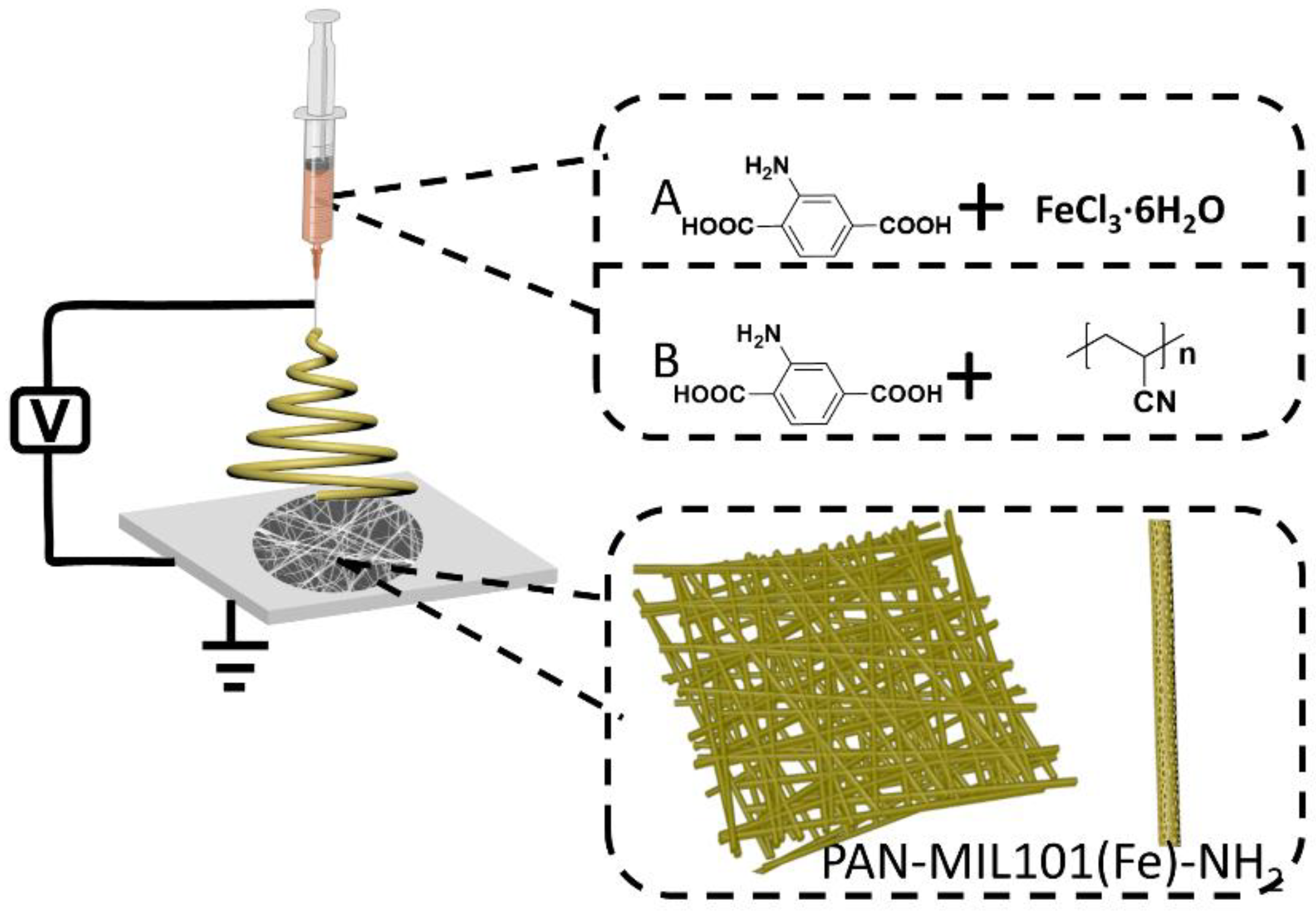

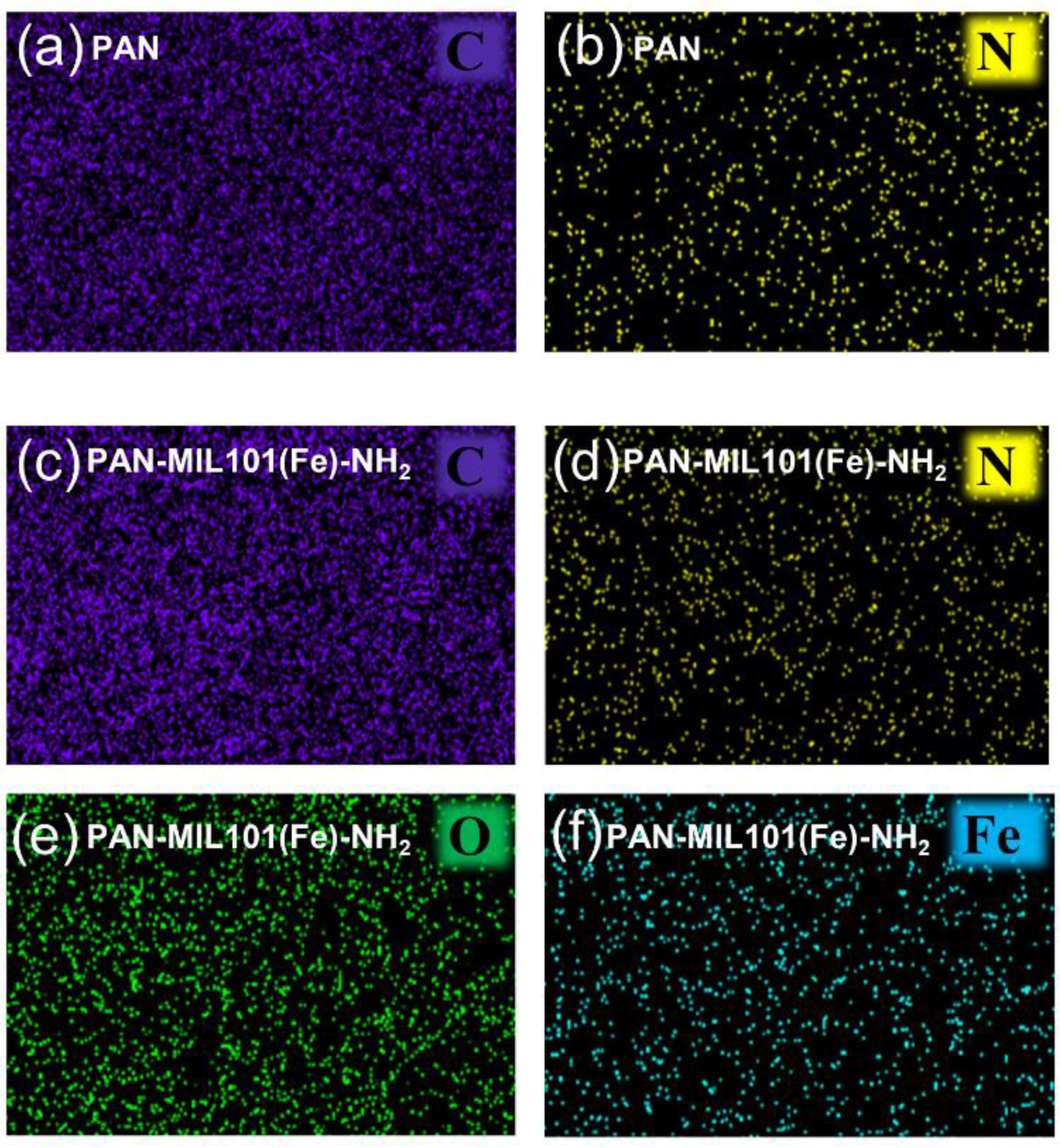
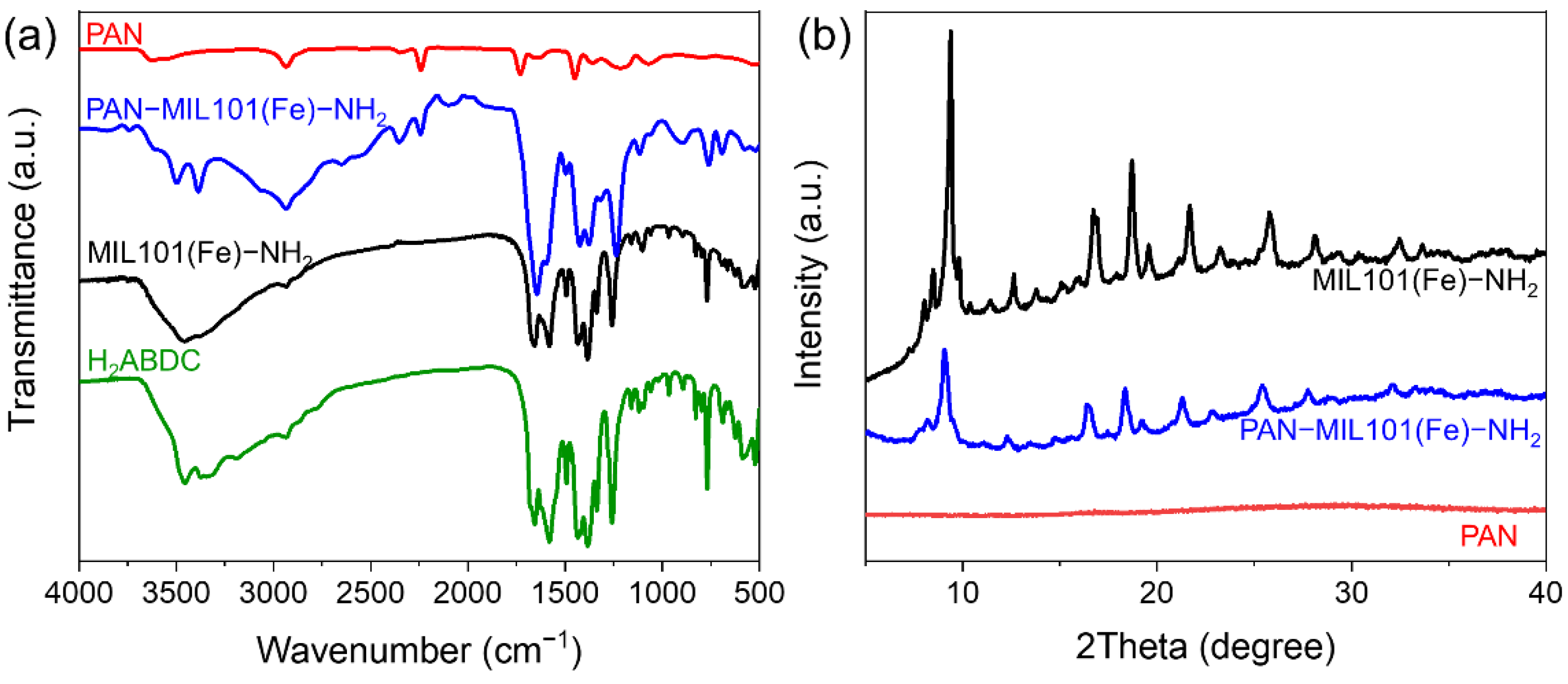
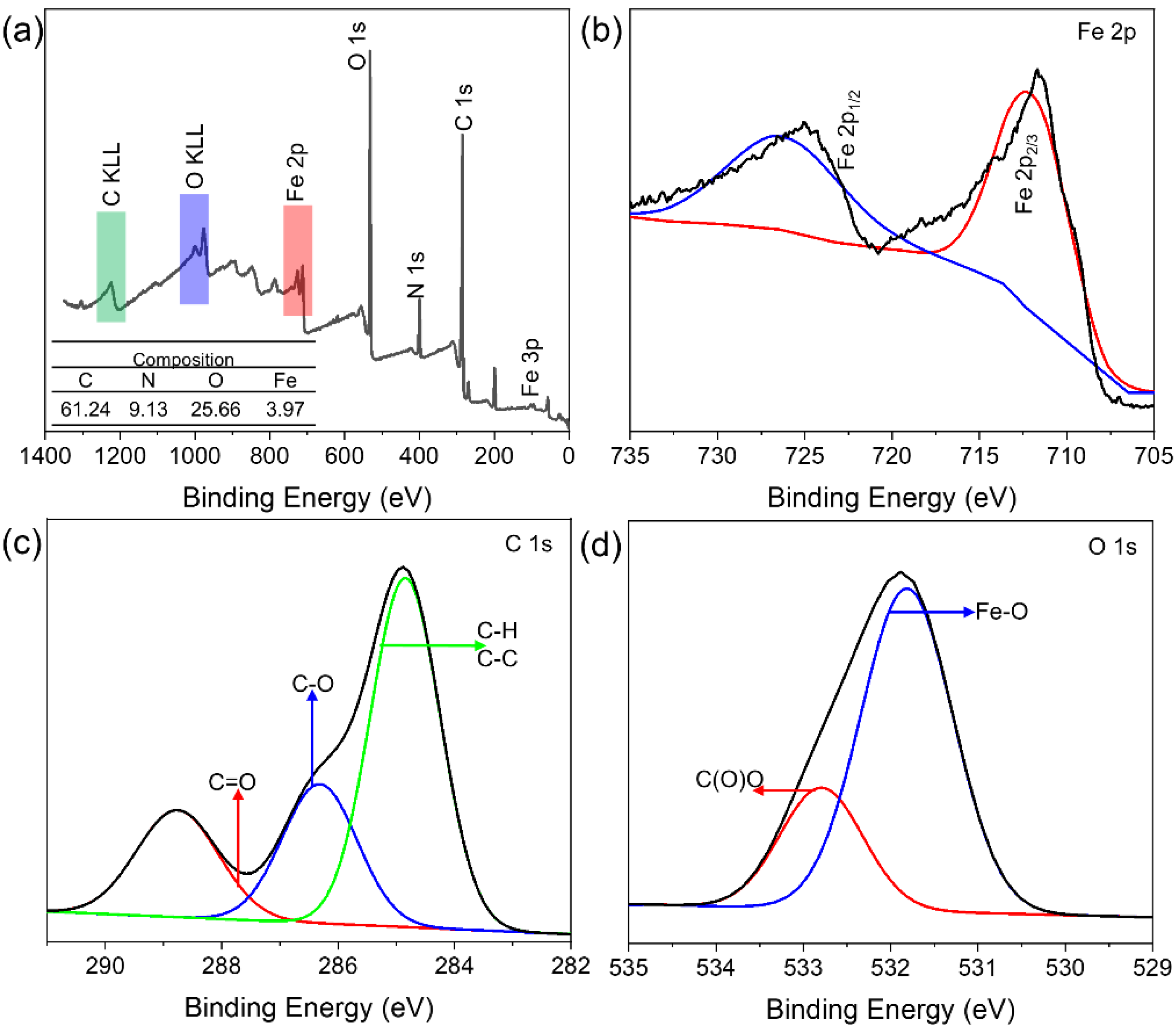
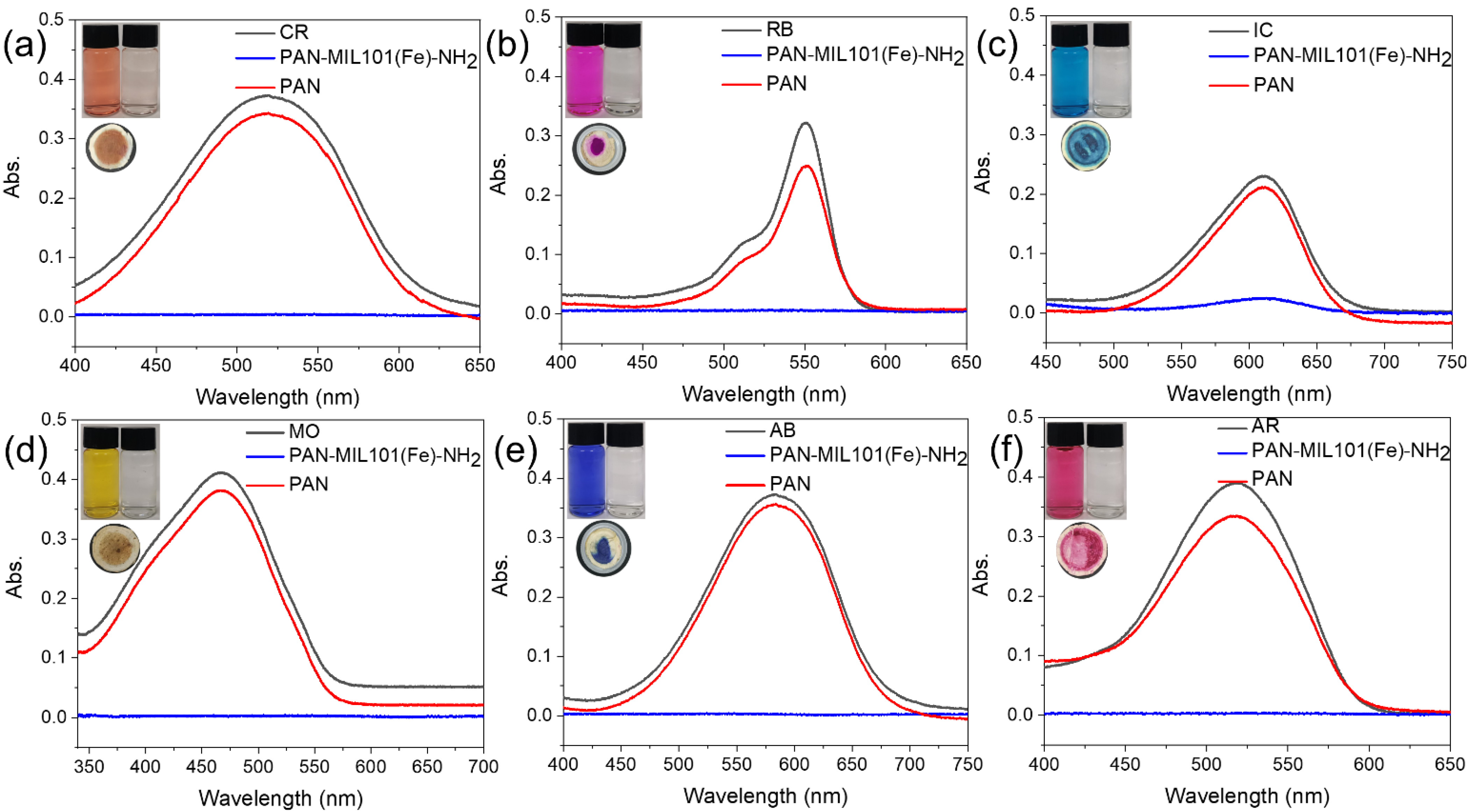

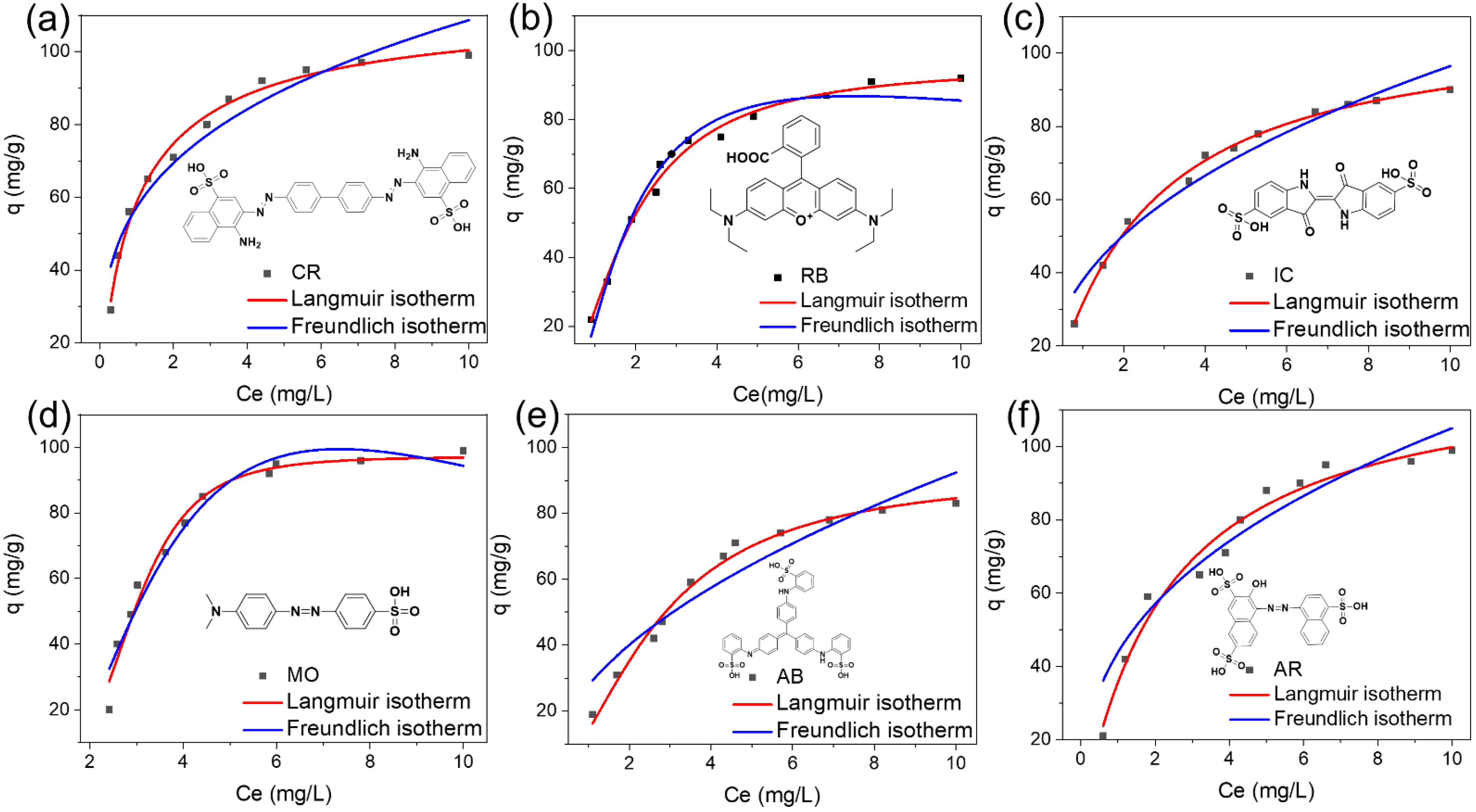

Publisher’s Note: MDPI stays neutral with regard to jurisdictional claims in published maps and institutional affiliations. |
© 2022 by the authors. Licensee MDPI, Basel, Switzerland. This article is an open access article distributed under the terms and conditions of the Creative Commons Attribution (CC BY) license (https://creativecommons.org/licenses/by/4.0/).
Share and Cite
Jia, J.; Wu, H.; Xu, L.; Dong, F.; Jia, Y.; Liu, X. Removal of Acidic Organic Ionic Dyes from Water by Electrospinning a Polyacrylonitrile Composite MIL101(Fe)-NH2 Nanofiber Membrane. Molecules 2022, 27, 2035. https://doi.org/10.3390/molecules27062035
Jia J, Wu H, Xu L, Dong F, Jia Y, Liu X. Removal of Acidic Organic Ionic Dyes from Water by Electrospinning a Polyacrylonitrile Composite MIL101(Fe)-NH2 Nanofiber Membrane. Molecules. 2022; 27(6):2035. https://doi.org/10.3390/molecules27062035
Chicago/Turabian StyleJia, Jiao, Hao Wu, Le Xu, Fengchun Dong, Yongtang Jia, and Xi Liu. 2022. "Removal of Acidic Organic Ionic Dyes from Water by Electrospinning a Polyacrylonitrile Composite MIL101(Fe)-NH2 Nanofiber Membrane" Molecules 27, no. 6: 2035. https://doi.org/10.3390/molecules27062035
APA StyleJia, J., Wu, H., Xu, L., Dong, F., Jia, Y., & Liu, X. (2022). Removal of Acidic Organic Ionic Dyes from Water by Electrospinning a Polyacrylonitrile Composite MIL101(Fe)-NH2 Nanofiber Membrane. Molecules, 27(6), 2035. https://doi.org/10.3390/molecules27062035





